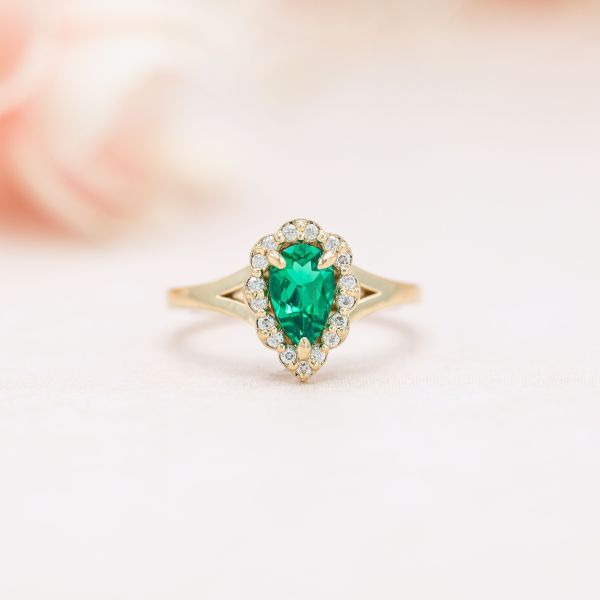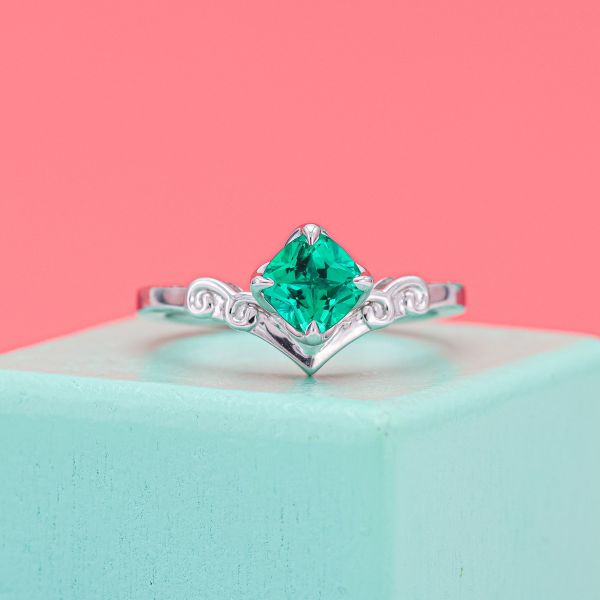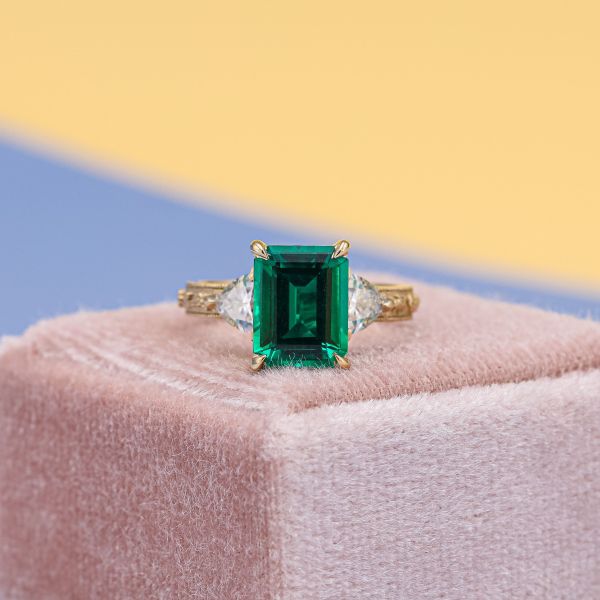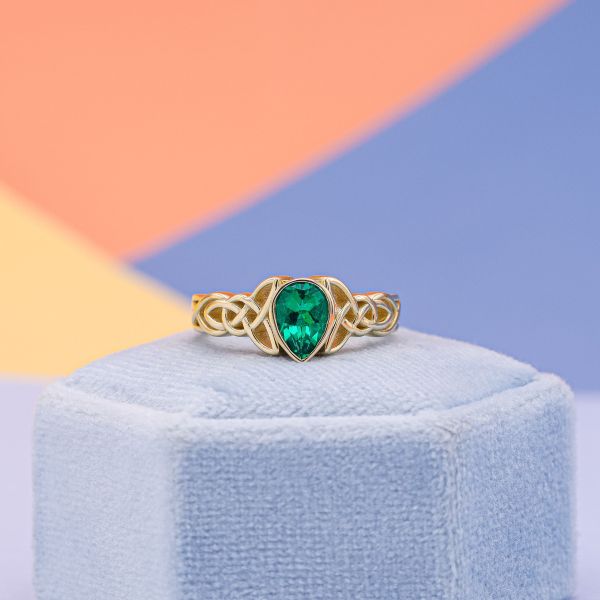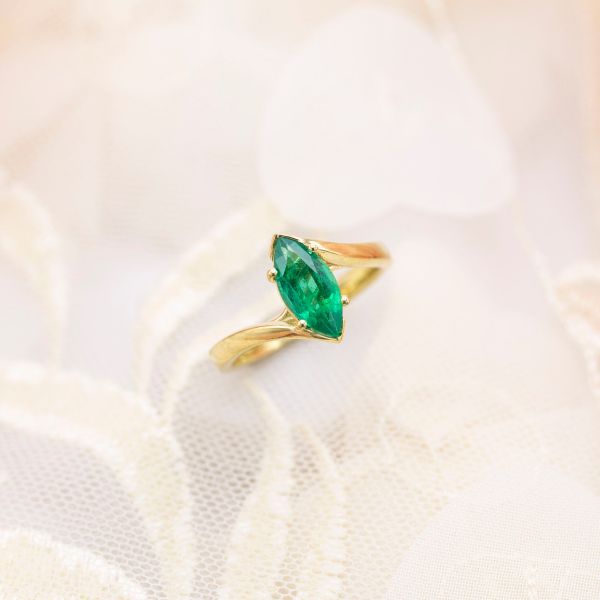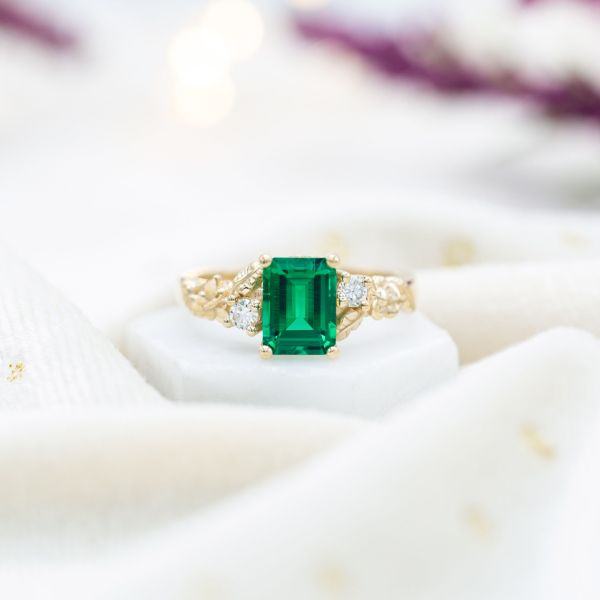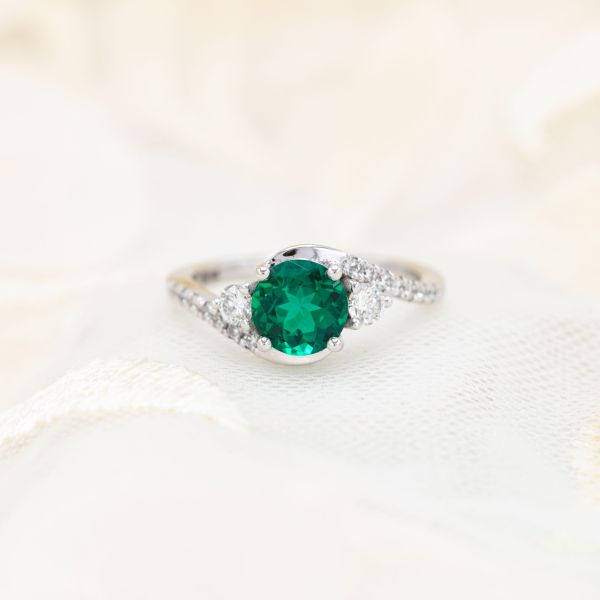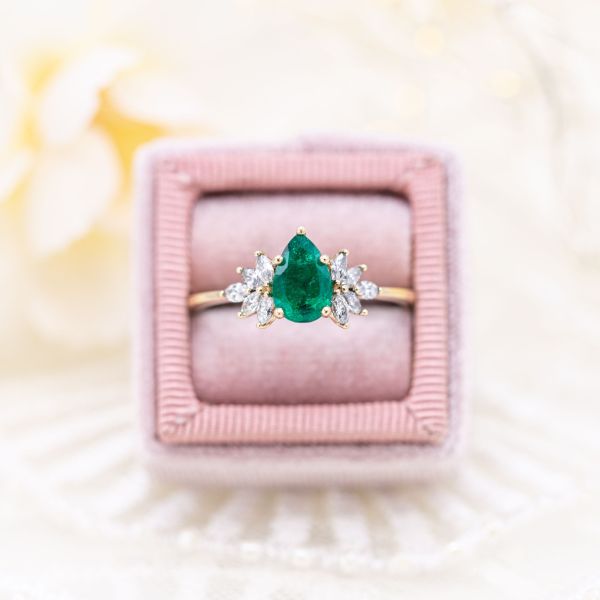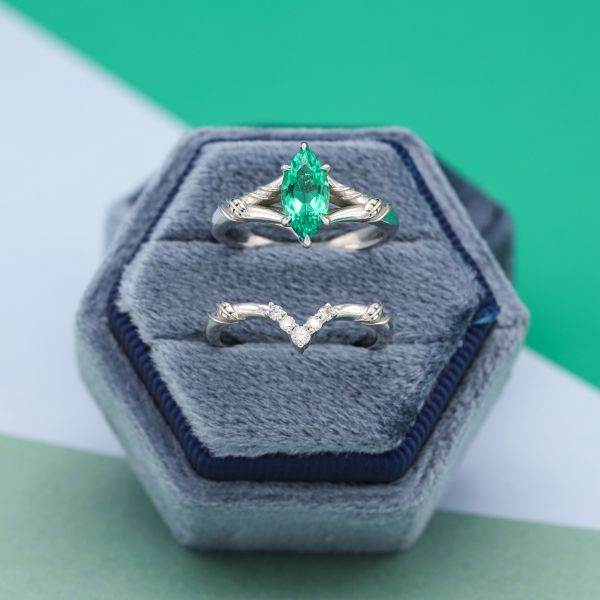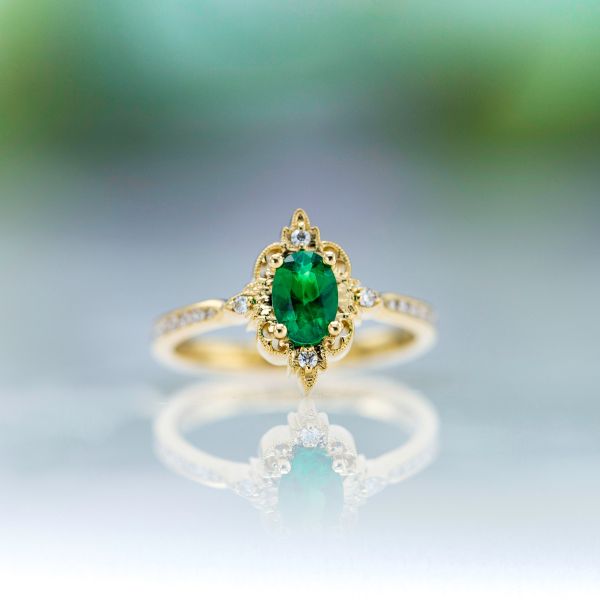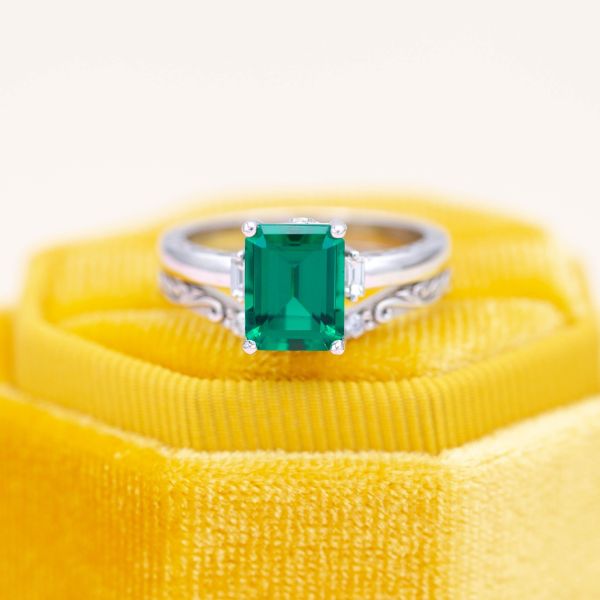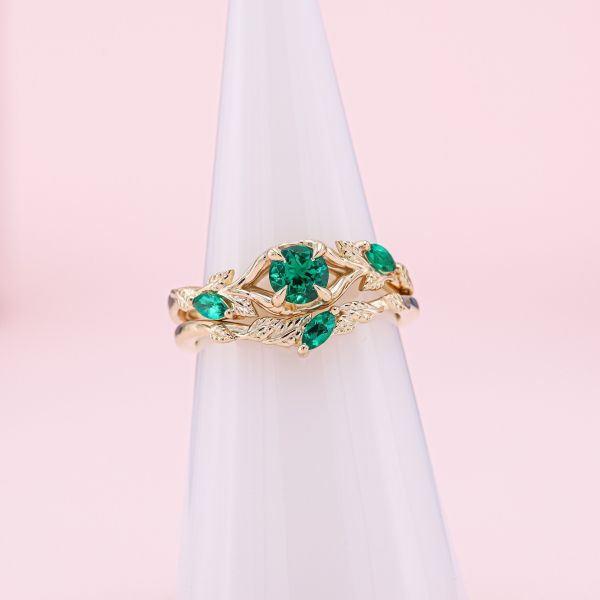Gemstone Knowledge
Exploring emerald's color
A thorough look at the rich green color of emeralds
Regal green with hints of cool blue
When imagining a green gemstone, your first thought is probably the lush color of an emerald. We’re right there with you: emeralds may offer a few slight variations in color, but most of us think of that classic, saturated green with subtle bluish undertones when envisioning one. And whether you opt for an emerald center stone for your engagement ring or not, we can agree they provide an exceptional pop of color to any bridal set! Now, it’s time for a closer examination of emerald’s color and what it takes to achieve that luxurious green look.
The oldest emeralds on record are a staggering 2.97 billion years old and were discovered in South Africa.
Hue, tone, and saturation
When describing a stone’s color, it mostly comes down to three terms: hue, tone, and saturation. We know what you’re thinking: do we really expect you to believe these three similar terms are actually three different facets of a stone’s color? Yes, we do! We’ve discussed each one in detail in our gem color guide, but here’s the gist of it:
- Hue is the actual color of the stone (blue, green, blue-green, purple, red, etc.).
- Tone describes how close to white or black the stone’s color is (light tones = more light for a better view of facets and shadows; dark tones = the stone’s color appears deep and opaque).
- Saturation refers to how much color is present within the stone (lightly saturated stones may appear almost clear or slightly tinted, whereas strongly saturated stones have concentrated color).
Now that we have the basic definitions out of the way, let’s start with hue! Emerald’s color comes from trace amounts of chromium and/or vanadium in its beryl structure, giving it a green hue. While it may be tempting to say emeralds are green, the fact is that high-quality emeralds are actually more than just green! That’s right, that vivid green we associate with emeralds actually has a hint of cool blue from traces of iron for a slightly bluish green appearance. But no need to go squinting at the next emerald you see to find those blue hints, because this blue coloration comes from subtle undertones in the stone’s overall hue and may not be immediately noticeable to non-experts.
Wait, gemstones can have undertones? Believe it or not, they can! Just like we can have “cool” or “warm” undertones to our skin that impact how certain colors look on us (and if you’ve ever had to search for that perfect shade of red lipstick, you know what we mean!), emeralds can have blue or yellow undertones that make them warmer or cooler in appearance. The finest emeralds have blue undertones (with blue making up about 10-15% of their overall hue) that enrich their color and give them depth, creating that lush “emerald green” we all know and love.
In contrast, yellow undertones (again, 10-15% of their hue) have a brightening effect and produce a grassy green hue that some couples prefer to the traditional emerald color, and these sprightly stones often come at a lower price than their “top quality” counterparts. So there you have it! When it comes to hue, top-quality emeralds are green with blue undertones for a cool green appeal, but emeralds can also come in mint, granny smith apple, and even spring green variations as well if you’re not committed to the lush green color.
On to tone: medium to medium-dark tones are preferred for high-quality emeralds, showcasing the stone’s green color without looking closed off or sacrificing the richness of that bluish green hue. Typically, tones lighter or darker than 75% are considered more affordable, so this tone level is pretty much the sweet spot when it comes to an emerald’s overall color! That said, some couples still fall for emeralds with light tones as well—they may not necessarily have the same depth as emeralds with darker tones, but they can reflect more light for a lively display of brighter greens.
Finally, saturation is a major factor in an emerald’s appeal, as it impacts whether a stone has a little or a lot of color. And, for most couples, the stronger the saturation the better! Natural emeralds can vary in saturation from light to strong, creating different displays of green color at each level. For instance, lightly saturated emeralds may be a pale mint green or very light spring green when compared to the richer colors of stones with medium or strong saturation. Overall, strong saturation is pivotal to that classic, regal green color, and the more vivid the saturation the more valuable the emerald!
Color variances in emeralds by origin
Did you know that the country from which an emerald was mined can actually determine its color? South America is the largest producer of mined emeralds in the world and Africa is a close second, and each country within these continents produces emeralds with slight variations in hue, tone, and saturation. We’re not talking hard and fast rules here: even one mine can produce emeralds with varying colors. Still, it’s interesting to see how different environments across the globe foster varied colors among emeralds! Here are a few examples from popular emerald mining locations.
When combined, the United States and Japan actually purchase more than 75% of the world's emeralds!
Colombia
The cream of the crop, Colombian emeralds are exactly what we think of when talking about “top-quality” color. These stones have a subtle blue undertone to their green hue with strong saturation for a lush, cool green color.
Zambia
Emeralds from Zambia feature an unusual blue-green/yellow-green pleochroism thanks to their high iron content. If you’re feeling a little lost, pleochroism is just a fancy term for facets of a stone exhibiting different colors at varying angles. For example, some facets may appear green or blue as you move the stone around, creating a soft, watercolor effect. Zambian mines even produce emeralds with sporadic color zoning—areas of varied color intensity—that look more like watermelon tourmaline!
Brazil
A more recent discovery, emeralds from Minas Gerais in Brazil also have that signature bluish green color we associate with high-quality emeralds. In fact, they’re so true to classic “emerald green” that they give Colombian emeralds a run for their money (in looks and price)!
Ethiopia
Ethiopia has produced emeralds since 2016, and the results have been promising! These stones range from grass green to blue-green in color, giving a slightly more diverse range of hues from just one country.
Lab emeralds
Lab emeralds technically have “different origins” than natural stones, right? And we’ll take any chance we can get to explain how similar they are to natural emeralds! In fact, lab emeralds are essentially the same as natural stones, offering enhanced durability and the same bluish green color.
Unlike natural and lab diamonds, if you were to view lab and natural emeralds side by side, you may notice some differences–particularly how uniform lab emeralds are in their color and lack of inclusions. Lab emerald lovers prize these stones for their perfect clarity and top color, whereas there’s nearly endless variety when it comes to the look of natural emeralds. In fact, many emerald lovers absolutely adore the shimmery intricacies of color caused by natural inclusions or jardin, which is French for garden. We only use lab emeralds that are grown and selected for “top color”, so you can have your cake and eat it too with this more durable and equally stunning version of emerald. Or, if you’re under the spell of that dreamy jardin, our team can help you find your ideal natural emerald as well!
Are emeralds treated for color?
It’s true that nearly all natural emeralds are treated with oil or resin, but we want to be clear that it’s not for color! Not that there’s anything wrong with color treatments, but almost all emeralds are au naturel when it comes to their signature green appeal. Like we mentioned before, natural emeralds contain jardin, or internal fractures that impact their durability. While these delicate imperfections can be quite a gorgeous addition to emerald’s appeal and are part of what makes each stone so unique, jardin is also responsible for making emeralds more susceptible to breakage. This means that while light bumps and scrapes shouldn’t hurt your stone, a good hit in the right direction on a hard surface could cause cracks to form.
As a result, natural emeralds are treated with oil or resin to help with durability and improve the overall look of the stone so it can maintain that vibrant color and sparkle. So, while emeralds don’t receive heat treatment for color enhancements, natural stones do receive those oil and resin treatments we mentioned to address some durability concerns. Although these treatments don’t intentionally impact color the same way heat treatments for other stones do, they do improve the overall look of the stone, enhancing clarity and making the emerald sparkle and shine. And we’ll never complain about a sparkly, shiny stone!
Conclusion
Contrary to what Kermit the Frog has to say about it, emeralds seem to find it very easy being green! But, is emerald the right stone for you? Outside of that regal green with blue undertones, there are minimal variations to emerald’s color, with grassy and mint greens being a few exceptions. There aren’t many stones that can compete with that luxe green hue though, and we can’t deny that emeralds look stunning at the center of engagement rings like the ones below that we’ve custom made for past clients!
About CustomMade
CustomMade designs and creates one-of-a-kind, custom engagement rings and fine jewelry. Each piece we create is inspired by you, designed for you, and made just for you.

